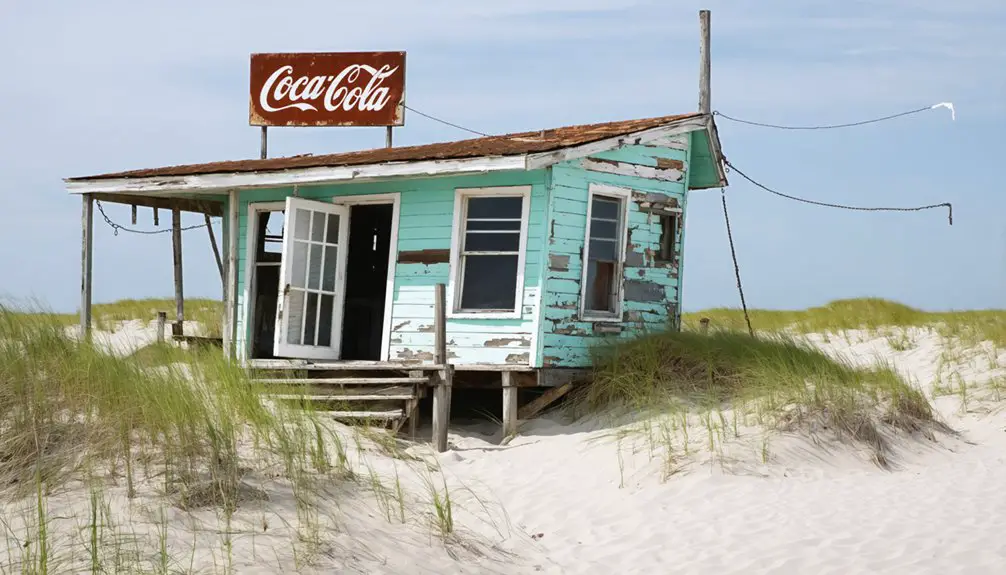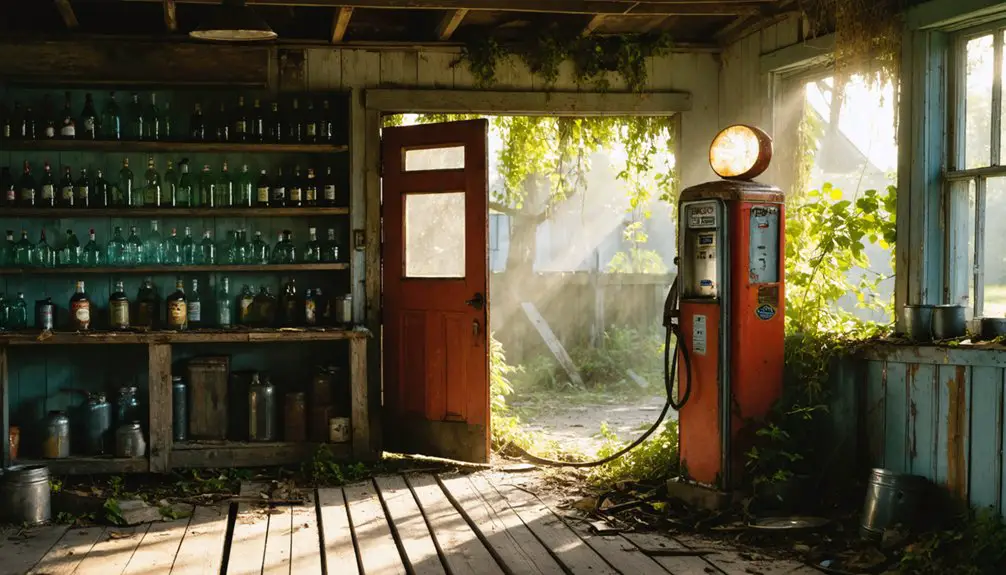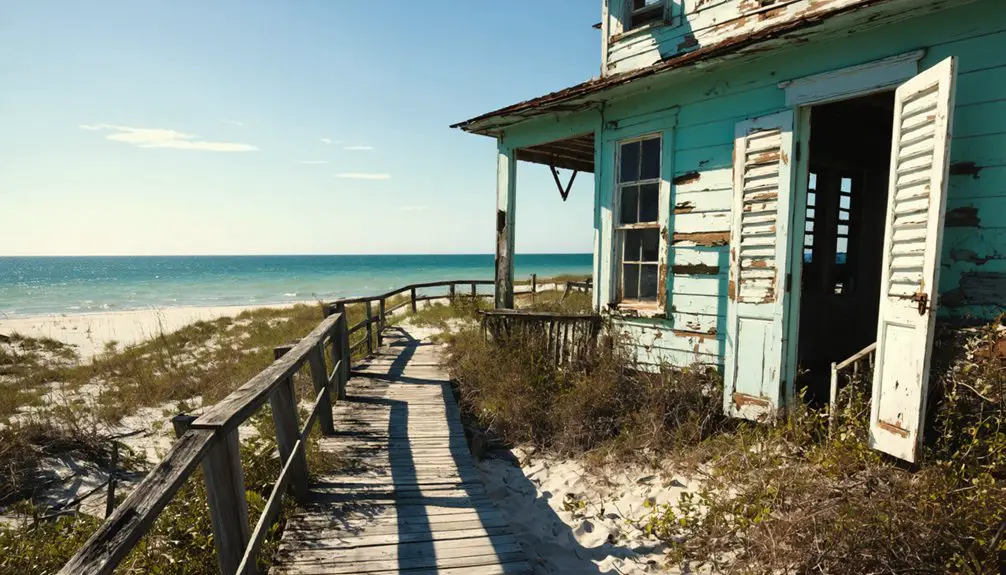You’ll find Sandy, Florida’s ruins tucked away along Tampa Bay, only accessible by boat today. This former military and agricultural settlement, established in the 1830s, once buzzed with over 600 residents enjoying theaters, bowling alleys, and communal mess halls. While nature has reclaimed much of the site, eleven buildings remain on the National Register of Historic Places, preserving remnants of Florida’s Spanish-American War era. Sandy’s abandoned streets hold countless untold stories.
Key Takeaways
- Sandy was established in the 1830s as a lumber and citrus farming community in Manatee County, Florida, before becoming abandoned.
- The town’s decline began after the Great Freeze of 1894-1895 devastated citrus crops and an 1898 sawmill fire damaged local industry.
- Sandy’s abandonment accelerated during the Great Depression, with reduced rail service and improved roads leading residents to seek opportunities elsewhere.
- Eleven historically significant buildings remain as protected landmarks, accessible only by boat from Tampa Bay’s ports.
- Nature has largely reclaimed the site, though visitors can still find crumbling brick roads and military structures from its past.
The Early Settlement Years
As settlers began staking their claims in Sandy during the 1830s, the region’s transformation from wilderness to settlement accelerated with Louis Maestre and Antonio Garcia’s pioneering land claims on Grassy Point in 1835.
The Armed Occupation Act of 1842 spurred further settlement patterns, bringing determined pioneers from Maine and New York who sought independence on the frontier despite ongoing Seminole conflicts. Several families arrived from Mount Carmel Church area seeking new opportunities.
You’ll find that early agriculture centered on citrus groves and diverse farming operations, with settlers strategically positioning their homesteads near essential oyster beds and fishing grounds. The area’s proximity to water resources proved crucial for the development of early industries and transportation networks.
Geography and Natural Surroundings
While many Florida ghost towns dot the coastline, Sandy occupies a distinctive inland position in Manatee County at 27°16′25″N, 82°06′56″W, surrounded by pine flatwoods and hardwood forests characteristic of central-west Florida.
Similar to Parmalee, another Manatee County ghost town located at coordinates 27°22.3N 82°13.2W, Sandy reflects the region’s settlement patterns.
The area’s topographic features include well-drained sandy soils typical of Florida’s inland scrub environments, with scattered ponds and wetlands enhancing the site’s ecological diversity.
Sandy soils and scattered wetlands create a diverse ecological mosaic within Florida’s distinctive inland scrub habitat.
You’ll find native oaks and palmettos thriving in Sandy’s humid subtropical climate, which receives about 50 inches of annual rainfall. Modern visitors can use keyboard shortcuts to navigate virtual tours of the area’s natural features.
Since its abandonment, the landscape has reclaimed former settlement areas, creating a natural refuge for local wildlife.
The ghost town now sits amid protected lands and rural properties, where you can observe the interplay between historical remnants and the returning natural environment.
Daily Life in Sandy’s Prime
During Sandy’s peak years, you’d find soldiers and their families gathering at the town’s modern entertainment venues, including the movie theater, bowling alley, and tennis courts where organized social events fostered a strong sense of community.
You could get your daily meals at the communal mess halls, which served as central gathering spots where military personnel and civilians shared stories over simple but filling dishes.
While the town’s commerce remained largely focused on meeting basic military needs, you’d have encountered service workers, hospital staff, and civilian contractors going about their daily routines, maintaining the delicate balance between military operations and community life. With a population of over 600 residents, the bustling military town required substantial infrastructure to support daily operations. Like many Florida communities that arose during the early 1900s boom, Sandy experienced rapid development to accommodate its growing population.
Social Activities and Recreation
Life in Sandy bustled with diverse recreational activities that brought together military personnel and civilians alike. You’d find community bonding opportunities at the movie theater, where residents gathered for evening entertainment, or at the bowling alleys that hosted friendly competitions.
Tennis courts provided outdoor recreation, while military barracks and officer quarters doubled as social hubs for organized events and functions. Like many Florida communities of its era, Sandy faced challenges from devastating hurricanes that threatened coastal infrastructure and activities. Just as severe freezes had impacted other Florida towns, Sandy’s outdoor activities had to adapt to weather challenges.
With a peak population exceeding 600 residents, Sandy’s social calendar featured military ceremonies, civilian celebrations, and shared holiday observances. You could join dances, public meetings, or regiment ceremonies that unified the town’s military and civilian populations.
The waterfront setting likely offered fishing and boating opportunities, while established infrastructure supported nighttime social gatherings and indoor recreational activities throughout the year.
Food and Community Dining
At the heart of Sandy’s daily operations stood several large communal mess halls that served as the town’s primary dining facilities. These practical spaces could accommodate hundreds of residents, with food traditions centered around efficient cafeteria-style service.
You’d find the daily menu focused on sustaining the workforce through:
- Salted meats, hardtack, and preserved vegetables as staples
- Fresh produce and fish when available from local sources
- Simple but hearty meals prepared on wood-fired stoves
The communal meals played a vital role beyond basic sustenance. They created natural gathering points where you’d interact with fellow residents, share news, and strengthen community bonds.
During special occasions like holidays, these halls transformed into festive spaces where the usual military-style dining gave way to celebratory feasts that brought together Sandy’s diverse population.
Local Commerce and Trade
While Sandy’s economic backbone rested firmly on the lumber trade, its commercial landscape flourished through a diverse network of businesses that served the town’s 1,000-strong workforce.
You’d find a bustling general store stocking everything from basic necessities to hardware supplies, while local trade thrived through economic partnerships between merchants and laborers. The Lutz Brothers Shingle Mill became a cornerstone business in 1895, setting the standard for lumber production in the region. The town’s bakery filled the air with fresh bread aromas, and mechanics kept essential equipment running for both transportation and agriculture.
The marketplace became a central hub where print shops, sawmills, and machine shops created a self-sustaining commercial ecosystem.
When the railroad arrived, it transformed Sandy into a regional trading post, connecting local businesses to broader markets and bringing steady streams of visitors to the town’s hotels and boarding houses.
Transportation and Accessibility

Transportation routes shaped Sandy’s rise and eventual decline, with multiple systems evolving over time to serve the settlement’s needs.
Like many Florida ghost towns, Sandy relied heavily on rail connections before automobile roads emerged. The Great Freeze of 1894-1895 devastated local transportation needs as agricultural shipments nearly ceased. You’ll find evidence of this transportation shift in the remaining infrastructure, where early dirt paths gave way to more developed routes.
- Rail service operated on a flag-stop basis, allowing residents to signal passing trains for essential supplies and transportation.
- Stagecoach routes initially connected Sandy to neighboring settlements, though these became obsolete once railroads dominated.
- Dirt paths and trails evolved into primitive roads, eventually contributing to the town’s demise as residents gained mobility through automobiles.
The changing nature of these transportation systems ultimately influenced Sandy’s fate, as improved road access made the population less dependent on rail service.
Economic Activities and Commerce
Sandy’s economic foundation rested primarily on citrus farming and logging operations, which flourished during the town’s peak years in the late 19th century.
You’d have found a bustling community supported by railroad commerce, with local stores and post offices serving the agricultural trade.
However, the town’s economic resilience was severely tested by the Great Freeze of 1894-1895, which devastated citrus crops. A devastating sawmill fire in 1898 dealt another blow to the local economy.
Agricultural challenges continued with the 1899 freeze, while the railroad’s decline further isolated the community.
The Great Depression delivered the final punch, causing merchants to close shop and residents to seek opportunities elsewhere.
Sandy’s failure to diversify beyond its agricultural and timber-based economy ultimately led to its abandonment.
The Path to Abandonment

Throughout the late 1890s, a perfect storm of challenges set Sandy’s abandonment in motion. Transportation shifts dealt the first blow as the rise of automobiles and improved road networks diminished the town’s strategic importance as a rail stop.
The changing community dynamics accelerated the decline, with younger residents moving to larger cities for better opportunities.
As opportunity called from distant cities, young residents answered, leaving their small town to quietly fade away.
The town’s fate was sealed by several critical factors:
- Limited road access isolated the community, making daily commerce increasingly difficult
- Natural disasters and harsh weather steadily deteriorated buildings and infrastructure
- The Great Depression delivered the final economic blow, eliminating remaining jobs and forcing families to seek opportunities elsewhere
Remaining Structures and Ruins
When you visit Sandy today, you’ll find the still-operational lighthouse standing prominently among the deteriorating military and civic structures that once formed this bustling coastal town.
The brick roads and concrete staircases that connected the community now lead you through a landscape of crumbling foundations, where eleven buildings listed on the National Register of Historic Places, including the Founders House cottages and art hall, remain as protected landmarks.
Among the northern section’s military remnants, you can explore the concrete gun emplacements and Fort Dade batteries, while scattered ruins of the hospital, power station, and various barracks tell the story of the town’s former residential life.
Landmark Buildings Still Standing
Despite years of abandonment, several significant landmark structures remain standing in Sandy, offering glimpses into the town’s former liveliness. The architectural significance of these preserved buildings showcases the town’s historical importance during Florida’s Spanish-American War era and early 20th-century development.
You’ll find remarkable examples of landmark preservation throughout the site:
- A collection of eleven National Register buildings, including the Founders House cottages, bakery, and art hall, which maintain their structural integrity.
- Military-era buildings raised on stilts, featuring officer quarters, barracks, and mess halls that reflect the town’s strategic importance.
- Historic commercial structures near the railroad, including general stores and mechanic shops that stand as evidence of Sandy’s once-thriving railway economy.
The buildings represent classic Florida agricultural and military architectural styles from 1882 through the mid-1900s.
Decaying Site Features Today
Today’s visitors to Sandy encounter a haunting tableau of structural decay and natural reclamation across the former town site.
You’ll find crumbling brick roads and collapsed staircases that once connected essential areas of this military outpost. The urban decay extends to residential zones, where exposed wooden frames and fallen roofs mark the remnants of family homes.
Historical relics from the military presence include rusted gun batteries and deteriorating observation posts, while nature steadily reclaims the landscape. Vines and tree roots pierce through concrete foundations, and moss blankets the fractured fort walls.
The town’s infrastructure lies in ruins – broken street lamps, fallen utility poles, and clogged drainage systems tell the story of decades of abandonment. Wildlife now claims these grounds as their domain.
Exploring Sandy Today

Visiting the ghost town of Sandy requires careful planning and a sense of adventure, as this historic settlement on Egmont Key is accessible only by boat from Tampa Bay’s ports.
The site’s historical preservation remains minimal, allowing nature to reclaim much of the former military installation.
When you explore Sandy today, you’ll encounter:
- Crumbling brick roads and deteriorating military batteries that hint at the site’s strategic past
- An operational lighthouse that still guides ships while serving as the island’s most prominent landmark
- Protected wildlife areas where you might spot nesting sea birds and native coastal vegetation
Remember to bring your own supplies, as there aren’t any facilities on site.
Weather conditions and seasonal closures can affect access, so check park advisories before your journey.
Legacy and Historical Impact
Sandy’s enduring legacy extends far beyond its abandoned structures, as the ghost town represents an essential chapter in Florida’s economic and social development during the late 19th and early 20th centuries.
You’ll find its impact woven into the region’s economic shifts, from bustling timber mills to the critical railroad networks that once sustained these communities.
The town’s cultural heritage lives on through archaeological discoveries and preservation efforts, revealing layers of history from pre-ceramic artifacts to early 20th-century homesteads.
Sandy’s story mirrors countless other Florida communities that rose and fell with changing industries.
Today, you can explore these protected sites, which serve as outdoor classrooms and research locations, helping you understand how social institutions, education, and religious movements shaped Florida’s development and identity.
Frequently Asked Questions
Were Any Paranormal Activities Ever Reported in Sandy?
While ghost sightings and haunted locations pepper Florida’s history, you won’t find documented paranormal activities in Sandy. Despite being a ghost town, it’s got no verified supernatural reports worth mentioning.
What Happened to the Original Residents After Leaving Sandy?
You’ll find Sandy’s history shows residents moved to nearby towns with better jobs, scattered across Florida using rail connections, and took up farming, turpentine production, or railroad work to sustain themselves.
Are There Any Buried Artifacts or Treasures Still Undiscovered?
You’ll find scattered household items and tools, but there’s no verified evidence of buried treasures or significant hidden artifacts in Sandy. Any valuable discoveries remain purely speculative without documented proof.
Did Any Notable Historical Figures Ever Visit Sandy?
You won’t find records of any famous visitors in Sandy’s history. While it holds local historical significance, there’s no documented evidence of nationally recognized figures ever visiting this location.
What Indigenous Tribes Lived in the Sandy Area Before Settlement?
You’ll find evidence of Chatot and Yuchi tribal history in the area, with earlier indigenous culture possibly linked to Southern Siouans and Biloxi peoples around 500 BC. The Timucua later inhabited this region.
References
- https://www.clickorlando.com/features/2025/04/21/floridas-creepiest-ghost-town-is-on-an-island-heres-a-look-at-whats-left/
- https://freepages.history.rootsweb.com/~gtusa/usa/fl.htm
- https://www.youtube.com/watch?v=zgf6tE2mrCU
- https://cccourthouse.org/wp-content/uploads/2023/12/Ghost-towns-and-Cemeteries-of-Citrus-County.pdf
- https://thesunshinerepublic.com/2025/01/05/the-ghost-towns-of-florida-abandoned-histories-and-nearby-comforts/
- https://www.emeraldcoastmagazine.com/ghost-towns-of-west-florida/
- https://floridatrailblazer.com/category/ghost-towns/page/2/
- https://www.youtube.com/watch?v=ov9YSsKtbDs
- https://www.palatkadailynews.com/local-around-putnam/exploring-putnam-countys-past-look-local-ghost-towns
- https://www.tiktok.com/@socialshepherdadventures/video/7342301852702100778



